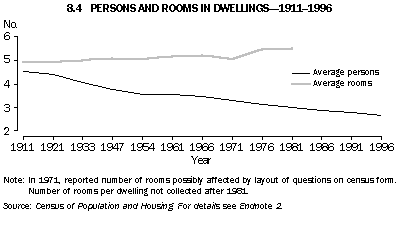CHANGING DWELLING AND HOUSEHOLD SIZE
Since data were collected in the first Australian Census in 1911, there has been a slow but steady increase in the size of Australian dwellings, as demonstrated by the rise in the average number of rooms over the period to 1981. This increase occurred despite a steady decline in the average number of persons per dwelling (from 4.5 to 3.0 persons) over the same period (graph 8.4). These changes have meant that, between 1911 and 1981, the average number of persons per room declined from 0.9 to 0.5 persons. The average size of new homes has continued to increase over the last two decades. Between 1986 and 1999, the average size of new dwellings increased almost 30% (to 185.5 square metres).1
